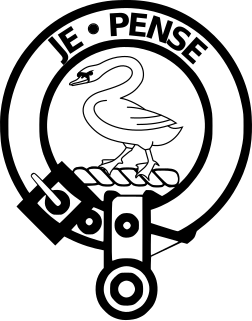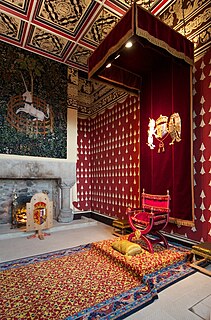| |||||
| Centuries: | |||||
|---|---|---|---|---|---|
| Decades: | |||||
| See also: | List of years in Scotland Timeline of Scottish history 1596 in: England • Elsewhere | ||||
Events from the year 1596 in the Kingdom of Scotland .
| |||||
| Centuries: | |||||
|---|---|---|---|---|---|
| Decades: | |||||
| See also: | List of years in Scotland Timeline of Scottish history 1596 in: England • Elsewhere | ||||
Events from the year 1596 in the Kingdom of Scotland .

Elizabeth Stuart was Electress of the Palatinate and briefly Queen of Bohemia as the wife of Frederick V of the Palatinate. Because her husband's reign in Bohemia lasted for just one winter, Elizabeth is often referred to as the "Winter Queen".

The House of Stuart, originally Stewart, was a royal house of Scotland, England, Ireland and later Great Britain. The family name comes from the office of High Steward of Scotland, which had been held by the family progenitor Walter fitz Alan. The name Stewart and variations had become established as a family name by the time of his grandson Walter Stewart. The first monarch of the Stewart line was Robert II, whose male-line descendants were kings and queens in Scotland from 1371, and of England and Great Britain from 1603, until 1714. Mary, Queen of Scots, was brought up in France where she adopted the French spelling of the name Stuart.

Clan MacDuff or Clan Duff is a Lowland Scottish clan. The clan does not currently have a chief and is therefore considered an Armigerous clan, which is registered with the Lyon Court. The early chiefs of Clan MacDuff were the original Earls of Fife, although this title went to the Stewarts of Albany in the late fourteenth century. The title returned to the MacDuff chief when William Duff was made Earl Fife in 1759. His descendant Alexander Duff was made Duke of Fife in 1889.

John Erskine, Earl of Mar was a Scottish politician, the only son of another John Erskine and Annabella Murray. He is regarded as both the 19th earl and the 2nd earl.

Ludovic Stewart, 2nd Duke of Lennox and 1st Duke of Richmond, Seigneur d'Aubigny in France, lord of the Manor of Cobham, Kent, was a Scottish nobleman who through their paternal lines was a second cousin of King James VI of Scotland and I of England. He was involved in the Plantation of Ulster in Ireland and the colonization of Maine in New England. Richmond's Island and Cape Richmond as well as Richmond, Maine, are named after him. His magnificent monument with effigies survives in Westminster Abbey.
William Ruthven, 1st Earl of Gowrie, 4th Lord of Ruthven was a Scottish peer known for devising the Raid of Ruthven.

Clan Wemyss is a Lowland Scottish clan.
James Colville, 1st Lord Colville of Culross (1551–1629) was a Scottish soldier, courtier, and diplomat.
Sir William Stewart of Houston was a Scottish soldier, politician and diplomat.
Sir John Carmichael was a Scottish soldier, the Keeper of Liddesdale, a diplomat, and owner of Fenton Tower at Kingston, East Lothian.
Alexander Lindsay, 2nd Earl of Crawford was a Scottish magnate. He was the son of David Lindsay, 1st Earl of Crawford and Elizabeth Stewart, daughter of King Robert II and Euphemia de Ross. He was knighted at the coronation of King James I on 21 May 1424, and subsequently was one of the hostages for King James given over to the English from 1424 until November 1427.
John Maxwell, 4th Lord Maxwell was a Scottish nobleman and patriarch of the Border Family / House / Clan of Maxwell.
Sir Richard Cockburn of Clerkington, Lord Clerkintoun (1565–1627) was a senior government official in Scotland serving as Lord Privy Seal of Scotland during the reign of James VI.

John Wemyss younger of Logie, (1569-1596), was a Scottish courtier, spy, and subject of the ballad "The Laird o Logie", beheaded for plotting to blow up a fortification at Veere in the Netherlands

The Masque at the baptism of Prince Henry, was a celebration at the christening of Prince Henry at Stirling Castle, written by the Scottish poet William Fowler and Patrick Leslie, 1st Lord Lindores.

Margaret Vinstarr, was a Danish or German courtier in Scotland to Anne of Denmark commemorated by the ballad "The Laird o Logie" for rescuing her imprisoned lover.
James Stewart, 1st Lord Doune (1529-1590) was a Scottish landowner.
Sir James Sandilands was a courtier to King James VI and I and captain of Blackness Castle
David Carnegie of Colluthie (1559-1598) was a Scottish landowner and administrator.
Sir John Wemyss (1558-1621) was a Scottish landowner.